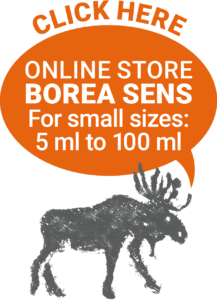Sweet gale Essential Oil

Latin Name: Myrica gale
French Name: Myrique Baumier
English Name: Sweet Gale
Family: Myricaceae
Origin: Quebec, Canada
Harvest time: July and August
Distilled Part: Twigs & Leaves
Organoleptic Specificities: Fresh and slightly peppery, light yellow to greenish liquid
Components: Myrcene, Germacrone, Limonene, α-Phellandrene, α-Pinene, Selin-11-en-4-α-ol
ORIGIN
Sweetgale is a small shrub that usually measures between one and two meters in height. It is found in the northern territories of Canada. In North America, it stretches between the Arctic Circle to the west and Ungava Bay to the east. It takes root along waterways and lakes, this helps in the stabilization of river banks. Sweetgale is thus found in moist and acidic soil.
The leaves of the plant grow in a spiral pattern along the branch and measure between 2 and 5 cm in length. From their base, the leaves widen until they form jagged teeth at the end. Droplets of resin cover the leaves and are at the origin of the plant’s second name in French: « bois-sent-bon » which means, «good smelling wood».
Like hops, Sweetgale is a dioecious plant, meaning it has male and female plants. Its flowers, also called kittens, do not have petals. The male flowers or kittens are recognizable because they are larger in size than the female kittens.
Flowering takes place before the appearance of new leaves in the spring. The fruit is used in particular as a spice once crushed and has a bract that supports its flowering in the aquatic environments that it borders.
HISTORY
Sweetgale has forged a place for itself in Amerindian communities and its use varies according to the community that is using it.
The Potawatomi used it particularly in the preservation of the wild berries they pick, covering their buckets with the plant.
The Ojibwa people used it as a dye. The seeds are a golden yellow color and are boiled to obtain a dye of the same color. They used this to dye wool, or as an infusion or decoction for its diuretic and stomachic properties.
First Nations also used it in fumigation to ward off mosquitoes, but also for its ability to promote lucid dreams.
BENEFITS
Physical
- Nervous System: calming, relaxing, promotes sleep and calms chronic pain.
- Osteoarticular System: anti-inflammatory +++, analgesic: decreases sensitivity to pain. Sedative and muscle relaxant.
- Skin System: anti-inflammatory +++, provides sedation, relaxation and calmness, repels insects.
Uses: Insomnia, anxiety, stress, nervousness, muscle cramps, torticollis, tendonitis, bursitis, insect repellent.
Contra-indications: No known contraindications to physiological doses. Avoid during the first three months of pregnancy and for people with hypotension.
Recommendation: Essential oils are wonderful for the well-being of humans, animals, insects and plants. There are many books that discuss aromatherapy and you should refer to them for proper and safe use. We also recommend that you consult a professional in aromatherapy who will be able to target the biochemical groups and aromatic molecules of essential oils and thus increase the effectiveness of your care.
Essential oils should be stored in a cool, dry place, protected from light and air.
The information provided on this website is NOT a recommendation of a cure or the treatment of a medical condition or disease.
Documentation
References
- https://espacepourlavie.ca/flore-biodome/myrique-baumier-bois-sent-bon
- http://repertoirequebecnature.com/vasculaires/Myrica_gale.html
- Frère Marie-Victorin, Rouleau Ernest, Brouillet Luc et collaborateurs, Flore laurentienne 3e édition, Gaëtan Morin Éditeur ltée, Montréal, Canada, 2002.
- Turbide, Michel, L’Aromathérapie, Huiles essentielles du Québec et du monde, Applications thérapeutiques, Édition Santé-Arôme, Collection Santé-Arôme, Otterburn Park, Canada, 2015

